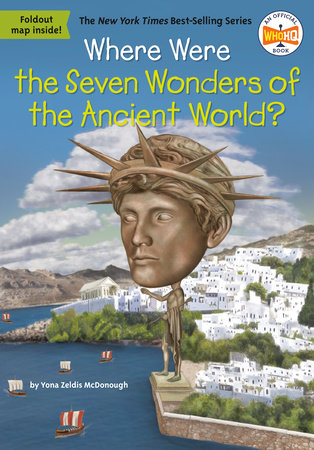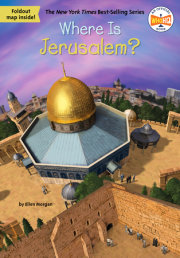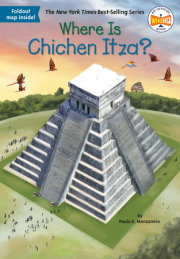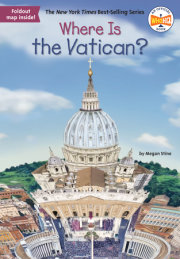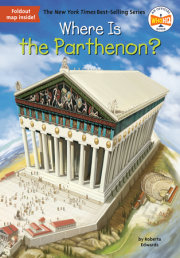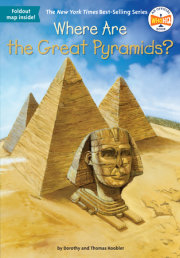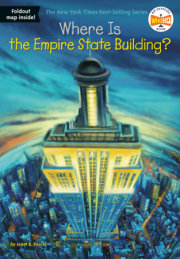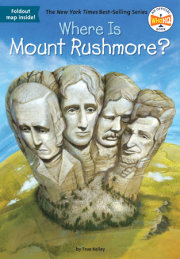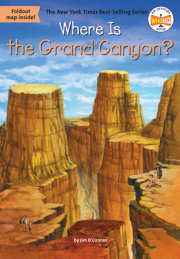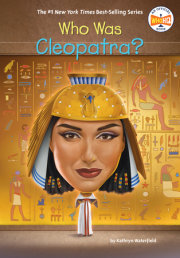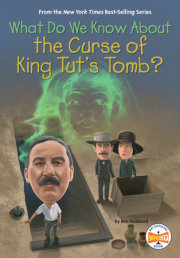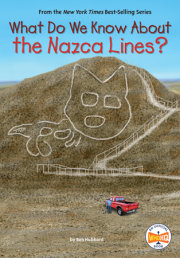Where Were the Seven Wonders of the Ancient World? Imagine you live thousands of years ago, somewhere in the area you see on the map. Even back then, people wanted to travel and see the world’s most famous landmarks. Several writers from ancient times did just that.
During their travels, they made lists of the most unusual and impressive sights. Not everyone wrote about the same places. But in the seventeenth century, seven of these marvels became known as the Seven Wonders of the Ancient World—-even though most of them no longer existed. In fact, only one remains standing today. Still, you can imagine what they looked like by reading books like this one.
Chapter 1:
The Great Pyramid at Giza Perhaps the most famous monument in the world is the Great Pyramid at Giza in northern Egypt. (A pyramid is a three--dimensional object with triangular sides that meet in a point at the top.) That’s because it’s so huge and old, and the story of why and how it was built is so interesting.
The pyramid at Giza was built by the Egyptians during the years 2550–2530 BC. Egypt was a great civilization even more than 4,500 years ago. The Egyptians were able to build a pyramid as tall as a fifty--story skyscraper. At its base, each side is about 756 feet long. That’s more than twice the length of a football field.
For longer than 3,880 years, the Great Pyramid remained the tallest structure made by human hands in the entire world—-that’s quite a record!
Unlike all the other ancient wonders in this book, the Great Pyramid is still standing. It is located outside the city of Cairo, on the Nile River. It’s made of over two million blocks of limestone and granite. Some of the blocks are so big and heavy that even today, no one knows exactly how builders in ancient times were able to put them in place. They are not held together with mortar (mortar is like concrete). Instead, the blocks fit next to one another so perfectly that the pyramid has stood for 4,500 years.
We know a lot about life in ancient Egypt because good records were kept and because so many objects—-both practical things and works of art—-were put in the tombs for the dead. Egyptians back then believed the soul needed all the same things in the afterlife that had been enjoyed in this world.
The Great Pyramid at Giza is one of these tombs, probably for a pharaoh (ruler) named Khufu. Khufu, like all pharaohs, had a special role. Not only was he the ruler of the people, but he was also believed to be a link between them and the gods. By performing certain ceremonies, the pharaoh made sure that the sun would rise and set, the Nile River would flow, and the crops would grow. And when the king died, he became a god. For this reason, everything about his death and burial was considered extremely important.
After Khufu’s death, his body was made into a mummy and put inside a highly decorated, body--shaped coffin. That coffin was then put into a sarcophagus (a stone coffin). Deep within Khufu’s pyramid, secret tunnels led to a room where his sarcophagus would have been surrounded by food, beautiful furniture, board games, precious jewelry, and so on. It was believed that his soul would rest in the chamber for eternity and, because of this, Egypt would thrive. Today, nothing remains inside the Great Pyramid. Why? Most likely robbers in ancient times broke in and looted all the treasure.
So we know what the Great Pyramid was for. We also know who built it. For many years, it was believed that slave labor was used to construct the pyramid. But that’s not true. Although there were enslaved people in ancient Egypt, the pyramid at Giza was built by paid workers, hired by the pharaoh.
During the time when the land and fields were flooded by the Nile, farming was impossible. So a lot of men were available to work. It’s believed that twenty to thirty thousand men were employed in the pyramid’s construction.
The question of
how the pyramid was built is much harder to answer. The huge stones were probably cut from quarries close to the Nile. Then big boats might have transported each block of stone to the site of the pyramid. One theory says wooden ramps ran around the outside of the structure, going higher and higher. Perhaps the blocks were dragged up the ramps by gangs of men and put into place. It’s possible, but we can’t be sure.
According to an ancient historian, building the pyramid took thirty years. Ten of those years were just to get ready—-preparing the site, building roads and homes for the workers, removing the stone from quarries.
The workers used copper and bronze metal tools, sleds (carts on runners pulled by animals) ropes, rollers, and levers. They didn’t have iron or steel tools, steam shovels, dump trucks, or cranes—-none of the things that are used in the modern construction of tall buildings. That alone makes building the Great Pyramid remarkable.
Once the Great Pyramid was completed, the facade (the outer surface) was covered in white limestone, which would have shone brilliantly and been visible from every direction for miles around. A capstone, probably covered in a layer of gold, was placed at the top. A capstone is a small pyramid at the point at which the triangular sides meet. What an astonishing sight it must have been!
Inside the Great Pyramid there are three known chambers. The lowest chamber was never finished. The so--called Queen’s Chamber and King’s Chamber are higher up within the pyramid structure. The inner rooms and walls are made of polished granite, one of the hardest stones known in Khufu’s time.
Alongside the pyramid at Giza are two temples, and a raised causeway, or road, to connect them. There are also places to leave food and other offerings for the dead pharaoh. One was close to the pyramid and the other was near the Nile River.
The area includes other smaller pyramids, known as the Queens’ Pyramids. Three remain standing at almost full height. They were built for other wives and sisters of the pharaoh. Another was almost entirely buried in the sand and discovered by accident. It was built for Khufu’s mother.
In addition, the complex has mastabas (say: MAS--tuh-buhz), which are much smaller flat--topped tombs built for Egyptian nobles.
Following Khufu’s death, his son became king and began building his own pyramid next to his father’s. Khufu’s grandson also built his eternal home at Giza. Both these pharaohs added their own temples and other monuments, such as the Great Sphinx of Giza. Still, neither of their tombs ever rose to the height of the Great Pyramid. Most likely, that would have pleased Khufu!
For thousands of years, money was set aside for Giza’s upkeep. But after Alexander the Great conquered Egypt in 332 BC and founded a new city called Alexandria, the pyramids at Giza began to fall into ruin.
The Great Pyramid was first fully excavated by a professional archaeologist between 1880 and 1882. (To excavate means to dig out a hole, sometimes in order to expose something that’s buried.) Sir William Matthew Flinders Petrie of Great Britain wanted to explore every aspect of the Great Pyramid, but he didn’t want to change or damage it. Because of him, we can enjoy the magnificent structure that still inspires awe in anyone who visits.
Chapter 2:
The Hanging Gardens of Babylon Two thousand five hundred years ago, Egypt was no longer the power it once had been. At this time, the largest and most magnificent city in the world was Babylon in a country known as Babylonia. (That’s in present--day Iraq.)
Babylon was famous for three things. One was a temple to the god Marduk. For the Babylonians, Marduk was the chief god.
The city walls of Babylon were another marvel. More than ten miles of wall enclosed the city. They were so wide that two chariots, each pulled by four horses, could pass each other on top of them.
The third famous landmark in Babylon was the fabled Hanging Gardens. They were built by King Nebuchadnezzar II (say: neh--byuh--kuhd--NEHZ--er). He ruled from 605 BC to 561 BC.
The name of the gardens is confusing. They didn’t actually hang in midair. They were built high above the ground on multilevel stone terraces within the palace walls. But from a distance, the gardens must have looked like they were floating, green and beautiful, above the dry, dusty city below.
According to legend, the king had them built to cheer up his wife, Queen Amytis (say: AH-mee--tiss). She had come from another land and was the daughter of a king. She married Nebuchadnezzar to create a strong bond between their two nations.
But Amytis didn’t like her new country. Not at all. It was flat, dry, and hot. She missed the green valleys and hills where she’d grown up. Nebuchadnezzar hoped that the gardens would remind her of home.
The hanging gardens were laid out in a giant square—-400 feet wide by 400 feet long. That’s even bigger than a city block. They rose more than 80 feet high—-that’s taller than a six--story building. The base of the garden was made of huge slabs of stone, tiles, asphalt (which is used in streets today), and reeds. It was deep enough that roots of big trees would have room to grow. Besides trees, there were shrubs, flowers, and vines planted in the gardens. There were also man--made streams, fountains, and waterfalls. Wild animals roamed freely. Greek and Roman travelers described it as a magical and enchanting place . . . even though none of them had actually seen it themselves.
One of many mysteries about the gardens is understanding how they were watered. Water would have to have been carried all the way to the topmost garden. And the gardens are estimated to have needed 8,200 gallons of water every day. To accomplish that would have been an amazing engineering feat, especially in ancient times.
King Nebuchadnezzar didn’t leave any records about how this was done. And although there are hundreds of documents describing many of his other building projects, there isn’t a single one about any gardens.
In fact, it’s entirely possible that the Hanging Gardens of Babylon may not have existed at all. Clay tablets from the time don’t mention them. Nor have any archaeological digs in the area turned up evidence of them.
But maybe the gardens
did exist—-only not in the city of Babylon. That’s what Stephanie Dalley of the University of Oxford claims. She believes that there were splendid gardens built around 340 miles north of ancient Babylon in Nineveh, on the Tigris River. (That would be near Mosul in modern Iraq.)
If that is true, the gardens would have been created by a different king who ruled one hundred years before Nebuchadnezzar. His name was Sennacherib (say: sen--NAH-keh-rib). He turned Nineveh into a magnificent city.
A system of eighteen canals, roughly fifty miles long, brought water from the hills to Nineveh. Given the scale of Sennacherib’s many grand projects, it’s possible that he could have designed and built the Hanging Gardens.
And we have Sennacherib’s own words:
I planted a great park beside the palace . . . with all kinds of herbs and fruit trees which came from the mountains and from Babylonia. So the mystery continues. Some historians and archaeologists believe that the gardens did exist and were destroyed by war and erosion. Others believe earthquakes eventually leveled the gardens. Whether they were built in Babylon or Nineveh or nowhere at all, the Hanging Gardens remain the most mysterious of all the ancient wonders. Were they real or just a fabulous fantasy?
Copyright © 2020 by Penguin Random House LLC. All rights reserved. No part of this excerpt may be reproduced or reprinted without permission in writing from the publisher.

